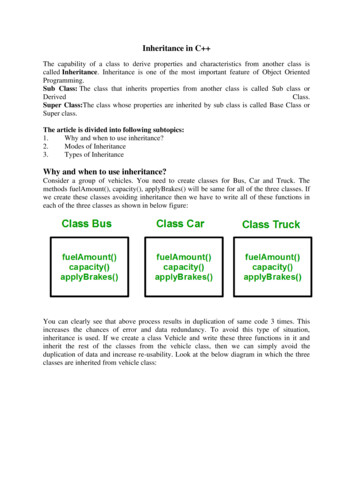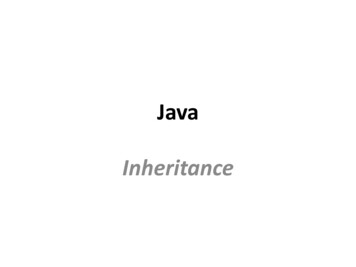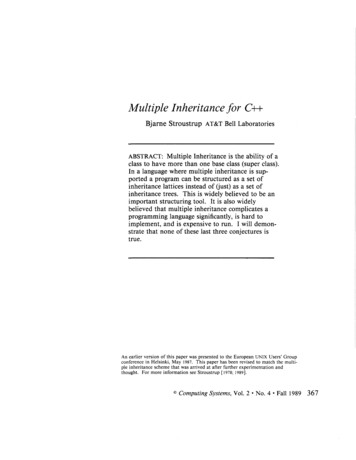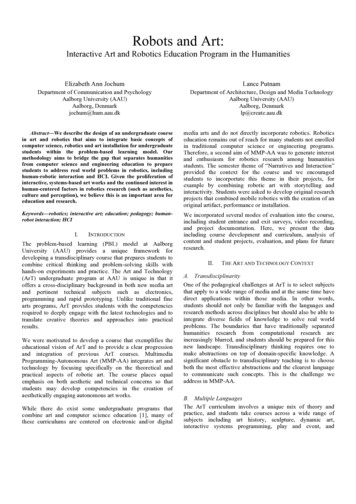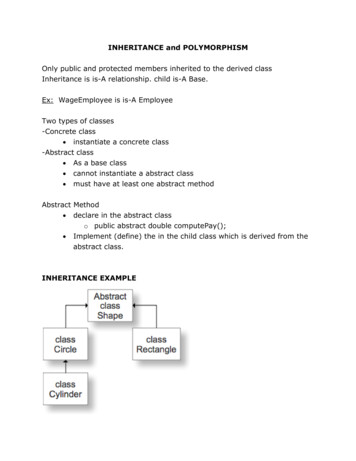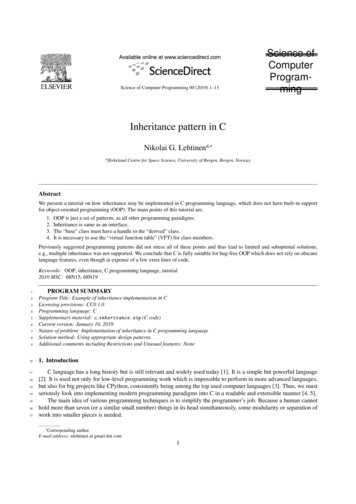
Transcription
Inheritance ReuseExtension and intensionClass specialization and class extensionInheritanceInheritance and methodsMethod redefinitionThe final keywordAn widely used inheritance example the composite design patternOOP: Inheritance1
How to Reuse Code? Write the class completely from scratch (one extreme). What some programmers always want to do! Find an existing class that exactly match your requirements(another extreme). The easiest for the programmer! Built it from well-tested, well-documented existing classes. A very typical reuse, called composition reuse! Reuse an existing class with inheritance Requires more knowledge than composition reuse.Today's main topic.OOP: Inheritance2
Class Specialization In specialization a class is considered an Abstract Data Type (ADT).The ADT is defined as a set of coherent values on which a set ofoperations are defined. A specialization of a class C1 is a new class C2 where The instances of C2 are a subset of the instances of C1.Operations defined of C1 are also defined on C2.Operations defined on C1 can be redefined in C2.OOP: Inheritance3
Extension The extension of a specialized class C2 is a subset of theextension of the general class C1.Extension of C1Extension of C2 “is-a” Relationship A C2 object is a C1 object (but not vice-versa).There is an “is-a” relationship between C1 and C2.We will later discuss a has-a relationshipOOP: Inheritance4
Class Specialization, ectangleSquareOOP: InheritanceRectangledraw()resize()Should the extensionsbe overlapping?5
Class Extension In class extension a class is considered a module. A module is a syntactical frame where a number of variables and method are defined, found in, e.g., Modula-2 and PL/SQL.Class extension is important in the context of reuse. Classextension makes it possible for several modules to share code, i.e.,avoid to have to copy code between modules. A class extension of a class C3 is a new class C4 In C4 new properties (variables and methods) are added.The properties of C3 are also properties of C4.OOP: Inheritance6
Intension The intension of an extended class C4 is a superset of theintension of C3.Intension of C4Intension of C3OOP: Inheritance7
Inheritance Inheritance is a way to derive a new class from an existing class. Inheritance can be used for Specializing an ADT (i.e., class specialization).Extending an existing class (i.e., class extension).Often both class specialization and class extension takes place when aclass inherits from an existing class.OOP: Inheritance8
Module Based vs. Object OrientedModule basedObject orientedC3C3C4C4 Class C4 is created by copying C3.There are C3 and C4 instances.Instance of C4 have all C3 properties.C3 and C4 are totally separated.Maintenance of C3 properties must bedone two placesLanguages, e.g., Ada, Modula2,PL/SQLOOP: Inheritance Class C4 inherits from C3.There are C3 and C4 instances.Instance of C4 have all C3 properties.C3 and C4 are closely related.Maintenance of C3 properties must bedone in one place.Languages, C , C#, Java, Smalltalk9
Composition vs. resize()Pure CompositionXa()b()Class extensionOOP: InheritanceLineRectangledraw()draw()resize() resize()Pure Inheritance(substitution)Yc()d()e()10
Inheritance in Javaclass Subclass extends Superclass {// class body od3()OOP: Inheritance11
Inheritance Examplepublic class Vehicle {Vehicleprivate String make;private String model;toString()public Vehicle() { make ""; model "";}getMake()public String toString() {getModel()return "Make: " make " Model: " model;}public String getMake(){ return make; }Carpublic String getModel() { return model; }}getPrice()public class Car extends Vehicle {private double price;public Car() {super(); // called implicitly can be left outsprice 0.0;}public String toString() { // method overwritesreturn "Make: " getMake() " Model: " getModel() " Price: " price;}public double getPrice(){ return price; }}OOP: Inheritance12
Class Specialization and Class Extension The Car type with respect to extension and intensionClass Extension Car is a class extension ofVehicle. The intension of Car isincreased with the variableprice.OOP: InheritanceClass Specialization Car is a class specializationof Vehicle. The extension of Car isdecreased compared to theclass Vehicle.13
Instatianting and gleRectanglePropertiesSquareSquarePropertiesSquare Instance The Square, that inherits from Rectangle, that inherits from Shapeis instantiated as a single object, with properties from the threeclasses Square, Rectangle, and Shape.OOP: Inheritance14
Inheritance and Constructors Constructors are not inherited. A constructor in a subclass must initialize variables in the classand variables in the superclass. What about private fields in the superclass? It is possible to call the superclass' constructor in a subclass. Default superclass constructor called if existspublic class Vehicle{private String make, model;public Vehicle(String ma, String mo) {make ma; model mo;}}public class Car extends Vehicle{private double price;public Car() {// System.out.println("Start"); // not allowedsuper(“”, “”);// must be calledprice 0.0;}OOP: Inheritance}15
Order of Instantiation and Initialization The storage allocated for the object is initialized to binary zero before anything else happens.Static initialization in the base class then the derived classes.The base-class constructor is called. (all the way up to Object).Member initializers are called in the order of declaration.The body of the derived-class constructor is called.OOP: Inheritance16
Inheritance and Constructors, cont.class A {public A(){System.out.println("A()");// when called from B the B.doStuff() is calleddoStuff();}public void doStuff(){System.out.println("A.doStuff()"); }}class B extends A{int i 7;public B(){System.out.println("B()");}public void doStuff(){System.out.println("B.doStuff() " i);}}public class Base{public static void main(String[] args){B b new B();b.doStuff();}}OOP: Inheritance//printsA()B.doStuff() 0B()B.doStuff() 717
Interface to Subclasses and ClientsC31.12.323.C44.The properties of C3 that clientscan use.The properties of C3 that C4 canuse.The properties of C4 that clientscan use.The properties of C4 thatsubclasses of C4 can use.4OOP: Inheritance18
protected, Revisited It must be possible for a subclass to access properties in asuperclass. private will not do, it is to restrictivepublic will not do, it is to generous A protected variable or method in a class can be accessed bysubclasses but not by clients. Which is more restrictive protected or package access? Change access modifiers when inheriting Properties can be made “more public”.Properties cannot be made “more private”.OOP: Inheritance19
protected, neRectangleSquareOOP: Inheritance20
protected, Examplepublic class Vehicle1 {protected String make;protected String model;public Vehicle1() {make ""; model "";}public String toString() {return "Make: " make " Model: " model;}public String getMake(){ return make;}public String getModel() { return Price()public class Car1 extends Vehicle1 {private double price;public Car1() {price 0.0;}public String toString() {return "Make: " make " Model: " model " Price: " price;}public double getPrice(){ return price; }}OOP: Inheritance21
Class Hierarchies in General Class hierarchy: a set of classes related by inheritance. Possibilities with inheritance Cycles in the inheritance hierarchy is not allowed.Inheritance from multiple superclass may be allowed.Inheritance from the same superclass more than once may be allowed.CAABBDCABACBCD “Multiple and repeated inheritance is a basic feature of Eiffel.”[Meyer pp. 62].OOP: Inheritance22
Class Hierarchies in Java Class Object is the root of the inheritance hierarchy in Java. If no superclass is specified a class inherits implicitly from Object.If a superclass is specified explicitly the subclass will OOP: Inheritance23
Method/Variable Redefinition Redefinition: A method/variable in a subclass has the same as a method/variable in the superclass.Redefinition should change the implementation of a method, notits semantics.Redefinition in Java class B inherits from class A if Method: Both versions of the method is available in instances of B. Canbe accessed in B via super.Variable: Both versions of the variable is available in instances of B. Canbe accessed in B via super. “There are no language support in Java that checks that a methodredefinition does not change the semantics of the method. In theprogramming language Eiffel assertions (pre- and post conditions)and invariants are inherited.” [Meyer pp. 228].OOP: Inheritance24
tPrice()Upcast Treat a subclass as its superclass// exampleCar c new Car();Vehicle v;v c;// upcastv.toString();// okayv.getMake();// okay//v.getPrice(); // not okay Central feature in object-oriented program (covered in next lecture)Should be obvious that a method/field cannot be made more“private” in a subclass when redefining method/field. However it can be made more public.OOP: Inheritance25
The Ikea Component List Problem A part can be just the part itself (a brick). A part can consists of part that can consists of parts and so on. Asan example a garden house consists of the following parts Garden house wallsdoor window knobwindow– frame– glassframeglassfloor Regardless whether it is a simple or composite part we just wantto print the list.OOP: Inheritance26
Design of The Ikea Component tsSingleprint()Listprint()add()remove()for all components cc.print() The composite design pattern Used extensively when buidling Java GUIs (AWT/Swing)OOP: Inheritance27
Implementation of The Ikea Component Listpublic class Component{public void print(){System.out.println("Do not call print on me!"); }public void add(Component c){System.out.println("Do not call add on me!");}}public class Single extends Component{private String name;public Single(String n){ name n; }public void print(){System.out.println(name);}}public class List extends Component{private Component[] comp; private int count;// uses parent classpublic List(){ comp new Component[100]; count 0; }public void print(){ for(int i 0; i count - 1; i ){comp[i].print();}}public void add(Component c){ comp[count ] c;}}OOP: Inheritance28
Implementation of The Ikea Component Listpublic class ComponentClient{ // Ikeapublic Component makeWindow(){ // helper functionComponent win new List();win.add(new Single("frame")); win.add(new Single("glass"));return win;}public Component makeDoor(){ // helper functionComponent door new List();door.add(new Single("knob")); door.add(makeWindow());return door;}public Component makeGardenHouse(){ // helper functionComponent h new List();h.add(makeDoor());h.add(makeWindow()); // etcreturn h;}public static void main(String[] args){ComponentClient c new ComponentClient();Component brick new Single("brick");Component myHouse OOP: Inheritance29
Evaluation of The Ikea Component List Made List and Single classes look alike when printing fromthe client's point of view. The main objective! Can make instances of Component class, not the intension Can call dummy add/remove methods on these instances Can call add/remove method of Single objects, not the intension.Fixed length, not the intension.Nice design!OOP: Inheritance30
The final Keyword Fields Compile time constant (very useful)final static double PI 3.14Run-time constant (useful)final int RAND (int) Math.random * 10 Arguments (not very useful)double foo (final int i) Methods Prevents overwriting in a subclass (use this very carefully)Private methods are implicitly final Final class (use this very carefully) Cannot inherit from the class Many details on the impacts of final, see the book.OOP: Inheritance31
Summary Reuse Use composition when ever possible more flexible and easier tounderstand than inheritance. Java supports specialization and extension via inheritance Specialization and extension can be combined. A subclass automatically gets the fields and method from thesuperclass. They can be redefined in the subclass Java supports single inheritance, all have Object as superclass Designing good reusable classes is (very) hard! while(!goodDesign()){ reiterateTheDesign(); }OOP: Inheritance32
Method CombinationDifferent method combination It is programmatically controlled Method doStuff on A controls the activation of doStuff on BMethod doStuff on B controls the activation of doStuff on AImperative method combination There is an overall framework in the run-time environment thatcontrols the activation of doStuff on A and B. doStuff on A should not activate doStuff on B, and vice versaDeclarative method combination Java support imperative method combination.OOP: Inheritance33
Changing Parameter and Return TypesAdoStuff(S x)SsMethod()BdoStuff(T x)TtMethod()class B extends A {void doStuff (T x){x.tMethod();}}A a1 new A();B b1 new B();S s1 new S();a1 b1;a1.doStuff (s1);OOP: Inheritance// can we use an S object here?34
Covarians and Contravarians Covarians: The type of the parameters to a method varies in the same way as the classes on which the method is defined.Constravarians: The type of the parameters to a method varies inthe opposite way as the classes on which the method is defined.OOP: Inheritance35
OOP: Inheritance 3 Class Specialization In specialization a class is considered an Abstract Data Type (ADT). The ADT is defined as a set of coherent values on which a set of operations are defined. A specialization of a class C1 is a new class C2 where The instances of C2 are a subset of the instances of C1. Operations defined of C1 are also defined on C2.

